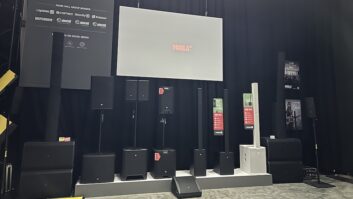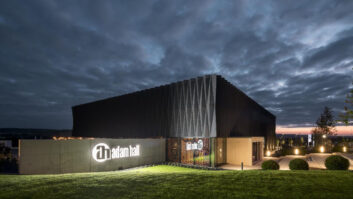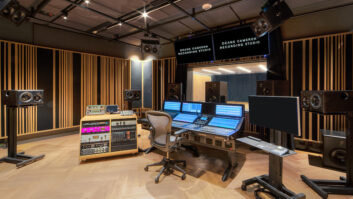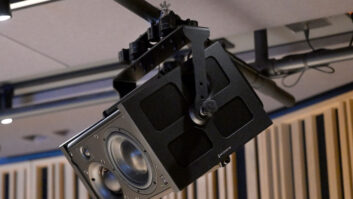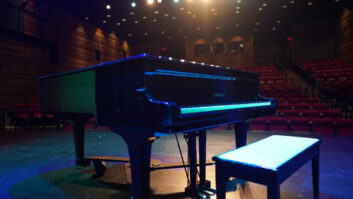
Compared to medicine or agriculture, the history of professional audio has been a comparatively short 125 years or so—barely a ripple in geologic time. But a whole lot has happened in that century and a quarter. True, other innovations also emerged in that era—from automobiles to aviation, telephones to television, exploring outer space to cyberspace—but for we true devotees, audio is what counts.
To recognize technical excellence and creativity in professional audio, the TEC Awards was established two decades ago. During the years, the TEC Hall of Fame and Les Paul Awards were added to honor individuals who made important contributions to our industry. The HOF members include Ray Dolby, Tom Dowd, Geoff Emerick, Roy Halee, Wally Heider, Deane Jensen, Quincy Jones, Eddie Kramer, Bob Liftin, George Lucas, George Martin, George Massenburg, Bob Moog, Rupert Neve, Les Paul, Sam Phillips, Bill Porter, Bill Putnam, Phil Ramone, Colin Sanders, Elliot Scheiner, Al Schmitt, Phil Spector, Willi Studer, Bruce Swedien, Rudy Van Gelder and Frank Zappa.
To expand the scope of the 20th annual TEC Awards, the Mix Foundation created a TECnology Hall of Fame to spotlight the long and rich history of the pro audio industry. Selecting just 25 inductees from a 125-year heritage turned out to be a difficult task, indeed. An elite committee of more than 50 industry leaders, engineers, producers, designers, educators, journalists and historians volunteered their time to help in this endeavor, and each was asked to pick 25 innovations (10 pre-1950 and 15 from 1950-1994), with the only “rule” being that any selections must be at least 10 years old.
Once the results were in, I was given the honor of tabulating the results and writing narratives that put each into a historical context. It wasn’t easy: Many manufacturers are long since out of business. At some companies, no one remains who has any knowledge of the product. Worst of all, the history of pro audio—our very lineage—is woefully neglected and sources are scarce, if not impossible to find.
As you read these, bear in mind that this is the first year of the TECnology Hall of Fame, and we plan to add more honorees in the future. So if your personal fave—such as the
1996 J-Con 1⁄4-inch-to-3-pin AC plug adapters—wasn’t included, there’s always next year. Send your comments/suggestions/corrections to [email protected] or [email protected]. In the meantime, set your time machine (analog, of course) waaaay back and enjoy this magic carpet ride through the annals of audio.

Thomas Edison with his phonograph/talking machine
THOMAS EDISON
CYLINDER RECORDER (1877)
There is no doubt that Thomas Alva Edison (1847-1931) played a major role in the development of recorded sound. Besides holding patents for more than 1,300 inventions such as incandescent lighting, the stock-ticker, fuses, electrical distribution systems and the kinetoscope “peep show” viewer, Edison’s landmark patent (USA #200,251) filed on Christmas Eve, 1877, eventually gave rise to an entire industry—even though the cylinder format that he developed was comparatively short-lived.
According to legend, Edison replayed the words “Mary had a little lamb” on the prototype “phonograph/speaking machine.” This first device was crude, using a diaphragm with a sharp point to etch variable-depth indentations in tinfoil wrapped around a hand-cranked cylinder, and the sound was replayed by a lighter diaphragm/needle combo tracking those same grooves. The cylinders were not removable, although Edison proposed removable foil sheets that could be reproduced by creating masters from Plaster of Paris molds.
In later patents, including the British BP 1644/1878 in late 1878, Edison proposed dozens of other phonograph concepts, including using discs rather than cylinders, wax materials rather than tinfoil, double-sided discs, electromagnetic recording/playback, electroplating and pressing manufacturing/replication, and even an amplification system based on compressed air. However, Edison was late in filing for Stateside protection on these claims and his U.S. patent was refused, leaving these concepts unprotected.
Meanwhile, Bell unveiled its Graphophone based on removable wax-paper cylinders; Edison countered with his 1888 “Perfected Phonograph,” which used a removable solid-wax cylinder. Other than making archival recordings, the main use of the Edison recorders was for transcription. All of this changed around the turn of the century, when molded cylinders became a reality and suddenly the market for music recordings opened up. Eventually, the popularity of cylinders began to fade (although Edison made them until 1929), and Edison reluctantly debuted his first commercial disc phonograph in 1912.

Emile Berliner demos the flat-disc Gramophone.
EMILE BERLINER
GRAMOPHONE DISC RECORDER/PLAYER (1887)
The origin of recorded audio is frequently attributed to Edison, yet Emile Berliner invented the flat-disc Gramophone that was the precursor to the modern record. Born in Hanover, Germany, Berliner (1851-1929) worked after school to help support his 10 brothers and sisters, but at age 19 was offered the opportunity to emigrate to America. He set off for the new land and ended up with a cleaning job in New York at the lab of saccharine developer Constantine Fahlberg. With America’s centennial in 1876, he moved to Washington, D.C., where he saw a demonstration of the Alexander Graham Bell telephone. Believing that its weakness was the transducer, he developed the loose-contact transmitter—essentially the carbon microphone—and sold the rights to American Bell Telephone, which hired him on as a research assistant.
After a few years, Berliner left to find his own research company. In 1886, he began examining Edison’s cylinder machines, looking for ways to improve their shortcomings, such as the fragile wax grooves and the difficulty of replicating dics. Rather than continue with the cylinder design, Berliner proposed a flat-disc system in 1887 (U.S. patent #372,786) using a wax-coated zinc disc as the recording medium. After the recording machine traced the stylus movements in the soft wax, the disc would be dipped into an acid bath that permanently etched the pattern into the zinc. A separate playback machine was required, and Berliner christened the system the “Gramophone.” Electroplating the master zinc disc would result in a stamper that could be used to create copies.
At first, the Gramophone was only released as a children’s toy, using small discs, but with Berliner’s formation of United States Gramophone Company, the world began to see the promise of recorded sound for the masses and the record industry was born. Berliner also had numerous other inventions, ranging from gyroscopic motors to “Parquet Carpet” floor coverings to acoustic tiles (1926 patent #1,573,475). Yet perhaps one of his most lasting acts was trademarking Francis Barraud’s now-classic “His Master’s Voice” painting of a terrier listening to a Gramophone (the company had the artist paint over the original cylinder player in the picture, replacing it with a Berliner disc reproducer), which became the well-known symbol for the Victor Talking Machine Company after it acquired Berliner’s business in 1902.

Photo: History San Jose; Used by Permission
LEE DE FOREST
TRIODE VACUUM TUBE (1906)
If audio would have followed the course of every other technology, then vacuum tubes would have been long forgotten by now. Yet anyone who’s ever plugged into a Marshall JTM45, Fender Twin Reverb, Vox AC30, Teletronix LA-2A or any other of hundreds of classic tube devices should give a silent nod to Lee De Forest.
Born in Council Bluffs, Iowa, in 1873 and reared in Alabama, De Forest had an aptitude for science from an early age. After receiving a Ph.D. from Yale in 1899, he turned his attention to the seminal field of radio.
Seeking to create a detector for electromagnetic radiation, De Forest began by examining John Fleming’s invention of the “electronic valve” (diode), which was fairly insensitive to variances in electromagnetic radiation. By simply adding a third electrode (grid) between the cathode (filament) and the plate (anode) of a diode, the conductance of the tube proved controllable. In this case, a fairly minute signal (voltage) at the grid would result in huge changes in the plate voltage, and the first amplification device was born. De Forest referred to his triode invention as “Audion” and received U.S. patent #879,532 for his discovery in 1907.
De Forest was granted some 300 patents during his life, including Phonofilm, a 1922 method of recording synchronous sound onto film that was unable to garner any interest in the film community. Eventually, the industry adopted an optical sound-on-film system that was similar to De Forest’s, but that was years after his De Forest Phonofilm company went bankrupt.

Western Electric engineer E. B. Craft (holding disk) demos the Vitaphone system. Note the synchronized turntable (on pedestal at rear or projector) and Western Electric 1B mic at top of photo.
WESTERN ELECTRIC/BELL LABS
VITAPHONE FILM SOUND (1926)
In terms of upheavals, the biggest revolution in 20th-century audio was surely the talking motion picture. In a matter of years, careers were spawned and ruined, and entire industries created and dismantled—all based on the rise of the “talkies.” Vitaphone (a 1925 co-venture between Warner Bros. and Western Electric) wasn’t the first—or even the last—film sound format to arise out of this new craze, but once the public had a taste of synchronous theater audio, there was no turning back.
Working in the Vitagraph Studio in Brooklyn, N.Y., Western engineers worked with a team from Bell Labs to create Vitaphone, a format using 16-inch discs running at 331/3 rpm on a projector-driven turntable, for a running time of about 10 minutes, which matched a single 1,000-foot reel of 35mm film. The format was less than ideal: A skip in the record or a film splice meant loss of sync; the system bandwidth was only about 4 kHz; and Vitaphone required an extreme needle force of 85 to 170 grams(!), meaning the life of the shellac disc was limited to a couple dozen plays, at best.
There were earlier film sound systems, ranging from General Electric’s Pallophotophone to Lee De Forest’s Phonofilm and a variety of earlier systems created at Western Electric. These were doomed mostly by studio/theater owners’ reluctance to make the substantial investment in playback equipment. But it was the Vitaphone touch on the 1927 The Jazz Singer that created a worldwide demand for film sound. Even with talking parts in a only few sections (mostly song numbers), the success of this Al Jolson mega-hit marked the beginning of the end for the silent screen.
The Vitaphone film+disc system that created the revolution was short-lived, replaced by the sound-on-film systems such as the GE/RCA variable-area soundtracks (the forerunner of today’s optical tracks) and Fox’s variable density system. But one key to the success of the Vitaphone was the availability of Western Electric sound systems, which not only helped popularize theater sound, but catalyzed the development of modern sound reinforcement systems. Ironically, the film+disc concept was revived 65 years later with the DTS (Digital Theater Systems) release of Jurassic Park in 1992, in which 6-channel audio on CD-ROM was locked to timecode on the film. [Note: The Vitaphone Project was formed to assist in the restoration of Vitaphone-format films—many of which exist today with picture intact but without sound disks. Contact www.vitaphoneproject.com for more info.—Ed.]

HARRY NYQUIST
NYQUIST THEOREM (1928)
It’s hard to imagine that a man born on February 7, 1889, in the small town of Nilsby, Sweden, would have such an enormous impact on modern digital production. Emigrating to the United States, Harry Nyquist attended the University of Dakota, receiving B.S. and M.S. degrees in Electrical Engineering before completing his studies with a Ph.D. from Yale in 1917. After graduation, he took a job with AT&T, doing research in improving the state of transmitting telegraph picture and voice signals.
But the (digital) world was forever changed in April 1928, when Nyquist published a lengthy paper in the AIEE Transaction. Entitled “Certain Topics in Telegraph Transmission Theory,” this unassumingly named article continued his earlier report about improving the speed of telegraph transmissions, but also proposed the basics of sampling continuous analog signals and converting them to a digital form. One of the tenets of digital audio, this Nyquist Theorem specifies that the highest reproducible frequency in a digital system is equal to or less than one-half of the sampling frequency. In real terms, for a digital system to reproduce the entire frequency range of human hearing—20 to 20,000 Hz—then the system has to sample the incoming signal at two times the highest input frequency, or 40 kHz. This doubled figure is known as the sampling rate or sampling frequency.
In 1934, AT&T’s Department of Development and Research was folded into Bell Telephone Laboratories where Nyquist continued his work in transmission engineering until retiring in 1954. Altogether, he received 138 patents during his tenure with the Bell System. Nyquist died in 1976—just as the digital era was beginning.

ALAN DOWER BLUMLEIN
STEREO PATENT (1931)
Born in London in 1903, Alan Dower Blumlein lived a short life, but during those 38 years, he changed the way that an entire world listens. After receiving his B.S. degree in 1923, he worked at Standard Telephones and Cables, but his main contributions to audio came after he joined the Columbia Graphophone Company in 1929. His early innovations included a moving-coil wax cutter head for gramophone lathes and a moving-coil microphone. Throughout the audio world, he is best known for his 1931 patent, simply entitled “Improvements In and Relating to Sound-Transmissions, Sound-Recording and Sound-Reproducing Systems.”
In this patent (British #394,325), Blumlein examines the physiology of the human binaural hearing process and the spatial illusion produced by “two or more loudspeakers”; describes the use of multiple microphones—including the crossed figure-8 (now known as the Blumlein technique) and Mid-Side stereo-miking methods; details a dual 45/45-degree phono cutter head for producing stereo record masters; and proposes a means of transmitting stereo radio. Many of the concepts in this patent did not reach fruition for decades to come, but all have had an enormous impact on the evolution of audio. Around the time of the patent, Columbia Graphophone Company merged with Gramophone Company (HMV), forming Electric and Musical Industries (eventually, this became EMI) and Blumlein stayed on, researching vacuum cathode ray tubes used in the Iconoscope for early TV cameras.
Blumlein was granted some 128 patents on subjects such as antennas and radar systems. In fact, it was such research that led to his death in 1942, when he and 10 others were killed during a secret flight testing a radar system. One can only guess at what wonders Blumlein could have devised had he lived another 38 years.

AEG
MAGNETOPHON TAPE RECORDER (1935)
The genealogy of the tape recorder can be traced back to Valdemar Poulsen’s early demonstration of magnetic sound recordings on a steel wire in 1899. Wire recorders never sounded very good, so in the 1920s, German inventor Kurt Stille came up with the concept of recording in steel ribbon—an improvement—but the medium was expensive and still couldn’t match the fidelity of a 78 rpm disc. In 1928, Fritz Pfleumer was granted a German patent for long paper strips coated with a magnetizable powder, which reduced the cost of ribbon recordings. In 1932, AEG chairman Hermann Bucher hired Pfleumer to work with Theo Volk and BASF chemist Friedrich Matthias to develop a magnetic tape recording system.
Innovations were many during the Magnetophon’s three-year development. In 1933, Eduard Schuller invented a ring-shaped magnetic head that created a concentrated magnetic field without touching the tape surface. The BASF group put carbonyl iron powder on a tough cellulose acetate-base material that could easily be edited, yet was strong enough to handle the torque of the transport motors.
In August 1935, the Magnetophon K1 was unveiled at the Berlin Radio Fair. The first serious recording using this portable, self-contained recorder was in November 1936, with Sir Thomas Beecham conducting the London Philharmonic at BASF’s concert hall near its manufacturing plant in Ludwigshaven. Other improvements followed, such as BASF’s ferric-oxide tape in 1939 and Walter Weber’s rediscovery and application of high-frequency AC biasing, which had been known since the 1920s, giving the 1941 Magnetophons a bandwidth of 10 kHz.

ALTEC LANSING
VOICE OF THE THEATRE SPEAKERS (1947)
From the big cities to the farms and small towns, American life in the post-WWII era was good. Besides the return of thousands of GIs from overseas, an end to wartime shortages and rationing meant that people could live it up and enjoy life without feeling guilty. Hollywood was booming and the theater business prospered, offering an evening of entertainment everyone could afford. So the timing was perfect when Altec co-founder Alvis A. Ward announced the original Voice of the Theatre Series in 1947.
Designed by John Hilliard, Voice of the Theatre was a line of high-performance, two-way cabinets made up of a number of huge (9- to 10-foot-tall) low-frequency enclosures that put one to four 15-inch Model 515 woofers on a wide-flare bass horn. The LF boxes supported large multicell horn(s) with the new Model 288 HF compression drivers, and could be mated with bolt-on wing panels that extended the bass response. It worked. In fact, the sonic improvements that Voice of the Theatre speakers offered made them an immediate hit with studios, theater owners and the general public. Approved by the Research Council at the Academy of Motion Picture Arts and Sciences, they became the industry standard for decades.
In the early 1950s, Altec unveiled the Voice of the Theatre A7, a compact (5-foot/180-pound!) two-way product suited for smaller cinemas and multichannel installs in the burgeoning stereo theater market, as well as for studio monitoring and home systems—the latter offered in a walnut cabinet model. The A7’s high 103dB (1W/1m) sensitivity made them an ideal match for the low-wattage power amps available at the time, and they became the popular P.A. choice of a zillion bars, clubs and rock bands throughout the 1960s and ’70s. More recently, Altec has reissued the A7 in a special “A7 Legacy” edition for the home stereo/pro market.

Bing Crosby with his beloved Ampex 200A recorders
AMPEX
MODEL 200A TAPE RECORDER (1948)
The story of the 200A—the first tape recorder from Ampex—is inextricably linked to the history of the German Magnetophon. After World War II, an engineer by the name of John Mullin brought two older Magnetophons back as war souvenirs, modified them for HF bias and demonstrated them to Bing Crosby, who used them to record, edit and play his weekly ABC radio shows. Helped in part by the U.S. government’s declaration that all German and Japanese patents were invalid, the decks were studied by the fledgling Ampex Corp., which launched its own recorder program.
The Ampex engineering team for the 200A included Harold Lindsay and Myron Stolaroff, who kept many of the Magnetophon’s basic features such as 30 ips operation and a B-wind design, in which the tape was wound with the oxide facing out. Unlike the portable Magnetophon, the Model 200A tape had a huge polished black wooden console and heavy anodized-aluminum fixtures and fittings. Recording one track across the full width of the 1⁄4-inch tape, the 200A was capable of performance that was flat within 0.5 dB from 30 Hz to 15 kHz.
In October 1947, the first 200A prototype was demo’ed at Radio Center in Hollywood; the enthusiasm by those who heard this wonder machine was apparent, and Ampex moved forward into regular production, with units serial #1 and #2 delivering in April 1948 in time to record and edit the 27th Bing Crosby show of the 1947-’48 season. A 200A retailed at $4,000—nearly as much as a house at that time—but the convenience of editing and the ability to time-delay performances appealed to Crosby, who no longer had to perform separate shows each week to reach different time zones. Weeks later, ABC ordered 12 more recorders and other broadcasters soon followed. In all, only 112 of the 200A recorders were made (the $1,500 model 300 followed it), but the impact of the benefits of tape-based production was felt throughout the world.

NEUMANN
U47 MICROPHONE (1949)
The U47 was not Neumann’s first microphone or even its first mass-produced condenser mic; those honors go to the CMV3 “bottle” condenser mic, which first appeared when Georg Neumann founded the company in 1928. However, as the first multipattern condenser, the U47 ushered in the era of the modern studio mic, and even more than 50 years after its birth, it remains one of the world’s most sought-after and desirable studio tools.
The U47 featured a high-performance (and now nearly impossible to find) VF14 tube and the dual-diaphragm M7 capsule—essentially back-to-back cardioid capsules that combine to create an omni pattern, or can be used singly for a cardioid pickup.
But the birth of the U47 was far from easy: Soon after the war, Neumann moved its plant back to Berlin in a rented building on Genestrasse, where the 10 Neumann employees had replaced the blown-out windows with cardboard, as no glass was available in the capital. But the company was determined, and Georg Neumann had a backlog of new ideas (such as his invention of the sealed NiCad battery) and was anxious to contribute to the reconstruction of Europe.
Due to distribution issues with Telefunken and post-war production snags, the U47 officially debuted in 1949. The Telefunken U47s—which other than the logo, were 100% identical to the models bearing the Neumann name—were sold to European broadcasters and to the U.S. market, where they soon replaced RCA ribbons as the studio mic of choice. Over the years, the accolades for Neumann products have been many. The company has garnered an unprecedented seven TEC Awards for microphone excellence, and received a Technical Grammy® Award in 1999 for the contributions of the Georg Neumann company over the years.

AKG
C12 Multipattern Tube Microphone (1953)
Besides making history as the first true multipattern microphone with remote polar control, AKG’s C12 sounded great (and is still highly prized today) and laid the foundation for more than a half-century of future AKG mic designs. Developed by AKG engineer Konrad Wolf, the C12 included an external box for selecting any of nine polar patterns, and its slender tubular housing was more compact than Neumann’s U Series and featured internal shock-mounting, so no external elastic suspension was required.
The heart of the sound of the C12 is its capsule, which uses a dual-backplate design invented by two Siemens engineers and results in consistent on-axis sensitivity when the polar pattern is changed. The C12’s CK-12 capsule paired the dual-backplate approach with two 10-micron diaphragms. (Two years later, the CK-12 capsule was upgraded to 6-micron Mylar capsules.) To expand AKG’s postwar distribution, the mic was also re-branded by Telefunken as the M251 and as Siemens’ SM 204. In the 1960s, as tube mics were losing popularity to the “convenience” of solid-state FET designs, the C12 was discontinued, later to resurface in slightly different forms. In 1983, “The Tube” used a C-414 capsule with the original C12 tube electronics but in a smaller body. The C12 finally reappeared in a more accurate re-creation in 1994, as the C-12VR (vintage reissue), which paired the C12 electronics with a re-tuned CK-12 capsule that simulated the acoustic signature of the orignal C12.
A stereo version of the C12, the C24, was created in 1959 by stacking two identical capsules that could be rotated to vary the stereo perspective. As with the C12, the polar patterns of both C24 capsules can be changed—again, nine choices are offered—so the mic is capable of X/Y, Mid-Side or Blumlein (crossed figure-8) stereo-miking.

EMT
Model 140 Plate Reverb (1957)
Today, with the proliferation of low- and high-end digital reverberation, room simulators and the like, it’s hard to recall a time when adding a little ’verb to a track was a complicated undertaking. Natural reverb has always been available, and it was always possible to create reverb while tracking using a distant room mic or placing your sound source in a reverberant space, such as a bathroom or stairwell. A few studios even went so far as to build reverb chambers—hard-surfaced rooms equipped with a mic or mics to pick up a speaker feed. Less well-heeled studios could always use their hallways in a pinch. However, electronic reverberation finally appeared with the debut of the Model 140 from German company EMT (Elektromesstechnik).
Developed by Dr. Walter Kuhl at the Institute for Broadcast Technology in Hamburg, the EMT 140 used the concept of vibrating a large, thin metal sheet (about 1×2 meters and half a millimeter in thickness). The metal plate was suspended by springs from a rigid metal frame enclosed in a heavy wooden case. The vibrations were generated by a center-mounted transducer (essentially a speaker-style driver) that was amplified and fed from an effects send, with the reverb output coming from a mic-style pickup transducer placed at the outside of the plate. The system’s “reverb time” was controlled (or at least kept from going out of control) by a damping pad that pressed against the plate.
The results hardly sounded like a cathedral but were thick and diffuse, and well-suited to vocals and drums. Given their massive size, 400-plus-pound weight and need to be placed in a vibration-free/noise-free space, plates were hardly the perfect solution but sounded far better than spring reverbs and were much cheaper than building acoustic chambers. In 1961, EMT debuted the Model 140S, which added a second output pickup for a stereo effect. Even with the power of modern DSP to conjure up almost any space, nearly all of today’s digital reverbs include plate reverb programs.

Teletronix
LA-2A Leveling Amplifier (1965)
Some 40 years after its invention, the story of the Teletronix LA-2A continues to be written, but one thing that remains constant is the demand for this mono optical tube compressor limiter, even in these days of digital production. Originally patented by Jim Lawrence in 1965, the LA-2A was produced by Teletronix in Pasadena, Calif., which soon after became a division of Babcock Electronics. A few years later, Babcock’s Broadcast Products division was acquired by Bill Putnam’s Studio Electronics Corporation, shortly before he changed the company name to UREI.
The LA-2A’s gain control scheme was revolutionary: Gain reduction was controlled by applying the audio voltage from a tube peak detector to an electroluminescent panel that glowed onto a light-sensitive, cadmium-sulfide resistor, with a second matched photoconductive cell controlling the metering section. With up to 40 dB of smooth gain limiting, flat 30 to 15,000Hz (±0.1dB) frequency response and low-noise performance, the LA-2A soon became a studio standard.
By 1969, tube gear had fallen out of favor, and the LA-2A was replaced with the “improved” solid-state LA-3A. Later, UREI was purchased by Harman Professional, which made a couple short (200-unit) reissue runs of the LA-2A—first in the late-’70s and then in the 1980s. In 1999, the sons of Bill Putnam regained the UREI brand from Harman and began manufacturing meticulously hand-built LA-2As, 1176s and other UREI studio gear under the Universal Audio brand, delivering the first products in May 2000. The industry’s reaction to these classic re-creations has been overwhelmingly positive. Imagine that.

Shure
SM57 Dynamic Microphone (1965)
How exactly does a $99 microphone become a Hall of Fame inductee? Well, if that mic is the Shure SM57, the answer comes easy. For four decades, the SM57 has proven itself in perhaps the most demanding application of all: delivering solid, dependable performance placed in front of amp stacks or an inch or so above (and below) snare drums, where the excruciatingly high sound pressure level would cripple lesser mics. Yet that same mic has been the presidential microphone of choice, capturing press conferences and speeches for every U.S. chief executive since Lyndon Baines Johnson. In fact, Shure even offers a “VIP Dual Microphone Kit” that includes all of the hardware and cabling to use two SM57s side-by-side for fail-safe vocal coverage of important events.
The lineage of the SM57 began when Shure engineer Ernie Seeler developed the Unidyne III capsule, a cardioid dynamic design that continued the evolution of Ben Bauer’s original 1939 Unidyne (the first single-element unidirectional mic). After three years of hard work and hundreds of tests involving dropping, throwing, cooking, salt spray immersion and submerging, the SM Series was born, and Seeler’s same capsule design was employed for the SM57 and its vocal counterpart, the SM58.
It’s somehow ironic that Seeler—a classical music devotee who despised rock ’n’ roll—created two of the mics that 40 years later remain a mainstay of rock music. Today, it’s the rare session—rock, pop, R&B or country, onstage or in-studio—that doesn’t have an SM57 on a drum kit somewhere, even when far-more expensive microphones are available.

Ray Dolby
Dolby A-Type Noise Reduction (1966)
Ray Dolby has lived and breathed audio since his earliest years. While still in high school, he worked at Ampex, first doing mundane chores such as copying alignment tapes for its new 200A tape recorder, and later as part of the company team that developed the first pro video recorder. After earning his BSEE from Stanford, he did postgraduate work at Cambridge, receiving a Ph.D. in Physics in 1961, followed by two more years of advanced studies. Dolby then spent two years working for UNESCO in India, during which time he considered ways of applying his thesis findings (on means of improving X-rays for clearer images) to noise-reduction methods for audio.
In 1965, he founded Dolby Laboratories to develop systems for reducing the background noise inherent in tape recording. The company’s first product was the A301, which debuted in 1966 and provided one channel of A-type noise reduction. This sophisticated audio compression/expansion system dramatically reduced background hiss inherent in pro recorders without discernible side effects. Unlike single-ended approaches, Dolby’s treated low-volume signals only, leaving the loud signals that naturally mask noise unprocessed and divided the spectrum into multiple bands to prevent the pumping (noise modulation) common to conventional wideband companders.
The effect of Dolby noise reduction on the world’s audio community—consumer and pro—was profound. It opened the possibilities of narrow-gauge/low-speed recording on formats such as the cassette tape and pro video recorders, as well home VCRs that would follow later. But on the pro audio side, Ray Dolby’s invention helped fuel the fire of a multitrack recording revolution—something we can all appreciate.

TEAC
1⁄4-Inch Simul-Sync 4-Tracks (1969)
Go back 35 years and there was no home recording market. In 1969, the first 24-tracks were becoming available, but choices for musicians were few—either go the full pro route or limit home recordings to stereo reel-to-reels, either with or without a “sound-on-sound” feature for layering new elements while recording over original creations, a “no-undo” process that required persistence and luck. At the same time, 4-channel consumer reel-to-reel decks for the quad market arrived; yet, with no provision for listening to earlier tracks while adding new tracks, overdubs were impossible.
Among those companies making quad recorders was TEAC, and in 1969, Dr. Abe and a small team of techs and marketing pros founded TEAC Audio Systems Corp (TASC, which in 1971 became TASC America or TASCAM) in a small office in Marina Del Rey, Calif. After opening as a custom shop to modify TEAC 4010 quad decks into the overdub-capable Simul-Sync TCA 40 Series, TASCAM soon began making mixers and recorders for the home recording market and first exhibited its products at the 1973 AES show. Eventually, the 2340 and 3340 lines sold tens of thousands of units to a growing market of musician-recordists, almost single-handedly launching the home recording revolution.
Long before audio education became an industry unto itself, TASCAM gear provided a learn-by-doing sort of self-guided audio apprenticeship. Untold numbers of today’s top recording engineers and producers learned the basics of multitrack music production (punch-ins/outs, console routing, optimizing gain structure, etc.), honing their skills on products such as TASCAM’s Model 2, Model 5 and Model 15 mixers. And as small format 4, 8 and 16-track recorders emerged, a new industry of garage recording was born, with hundreds of today’s large studios starting out from such humble beginnings.

Lexicon/Gotham
Delta T-101 Digital Delay (1971)
Pro audio was forever changed when Lexicon introduced the world’s first commercial digital audio processor in 1971. The story began at MIT, where Dr. Francis Lee developed a digital delay unit for heartbeat monitoring. A teaching assistant, Barry Blesser (who years later would design the EMT 250—the world’s first practical digital reverb), suggested that they try running audio through the system. The experiment resulted in a 100ms audio delay line, which was state-of-the-art for that time. Once the late Steve Temmer of New York City’s Gotham Audio heard about it, he commissioned 50 units to help overcome live sound propagation delays and as a pre-delay for plate reverbs.
Thus, the Delta T-101 was born, with “Gotham Audio” on the front nameplate and “Lexicon” on the back. The original unit offered a 10kHz bandwidth and a 60dB signal-to-noise ratio—less than stellar, but remarkable for its time. Lexicon definitely felt that the specs were capable of improvement and the result was the Delta T-102 (sold under the Lexicon name), which pushed the noise down to an acceptable -90 dB and helped convince the industry that digital audio was a viable proposition.

JBL
4311 Studio Monitors (1974)
Once upon a time—meaning about 30 years ago—monitors in U.S. studios were either custom designs (typically developed from JBL or Altec components), Altec 604E coaxials in “utility” cabinets or JBL’s large 4320 two-way horn systems. Based on the success of the 4320s, which had been designed with Capitol Studios and later developed a worldwide following, even being adopted as the standard studio monitor for Britain’s EMI, JBL began looking into other studio products to expand its market share. The answer was the 4310, a high-powered three-way, all-cone system that was small enough to be suspended or placed on a shelf or console top.
The 4310 was a hit, but some at JBL felt that the 4310’s popularity in the consumer realm would dilute its appeal to professionals. The 4310 then morphed into the L100, a hugely successful home product with the cool sculpted foam grilles; and JBL developed the 4311—an “all-pro” successor to the 4310.
The 4311 was built ground-up to be a “studio” monitor: It was available in textured gray or walnut finishes; the 12-inch 2213 cast-frame woofer had a 3-inch voice coil and a beefy 6.5-pound magnet structure; the 1.4-inch cone/dome tweeter had a foam surround to reduce diffraction effects; and it had easy-access, front panel presence and brilliance controls. But the 4311 had one feature not found on any of JBL’s home speakers: Offering tightly clustered components that provided coherent imaging when the speakers were used in close-in listening, the 4311 was ideal for near-field applications such as meter bridge placement. In a matter of years, survey after survey from trade magazines noted that JBL monitors consistently led all others in its share of the studio monitor market.

With Visa card in hand, Abbey Road Studio manager Ken Townsend buys an SSL 4000 from Colin Sanders.
Solid State Logic
SL 4000 Series Studio Console (1977)
There are many terms used to describe innovators in technology, but “visionary” certainly applies to Colin Sanders. More than 25 years ago, his design for the Solid State Logic SL 4000 mixer defined the modern recording console and changed an entire industry.
Sanders founded SSL in 1969 at age 22 to build electrical control systems for church organs. By the early ’70s, SSL moved out of Sanders’ parents’ house in Oxford to a nearby village where a workshop and studio were set up. When Sanders decided to upgrade the studio for multitrack capability, he launched an intensive R&D project, studying existing consoles, while planning to add advanced features such as computerized automation, dynamics and transport control. Clearly, the board was designed for production-scale manufacturing from the very start, and the basis for a commercial product was underway.
At the 1977 AES convention in Paris, SSL debuted the first 4000 Series console, complete with Studio Computer. Though a well-known UK studio owner remarked, “No one will ever buy a console with a television in it,” the board was sold in August ’77 to Dick Cadbury’s private studio near Oxford. The mixer had all the earmarks of the 4000 range: in-line channels, small faders, track-arming and dynamics on every channel, computer-controlled automation and tape machine control. Later models continued the refinements (the current version is the SL 4000 G+) and today there are more than 3,000 SSL-equipped studios and facilities worldwide.
Sanders left SSL in 1991 to pursue various non-audio projects, including high-tech induction cooking systems and water filtration technologies. Sanders, an avid pilot, died in 1998 when his helicopter crashed outside his estate in a light fog.

Thomas Stockham
Soundstream Digital Recording System (1977)
For those who believe “digital” began with digital audio workstations in the late 1980s, it’s important to remember that the first commercial digital recordings were made using Dr. Tom Stockham’s Soundstream Digital system in 1977. After demonstrating some opera demo recordings at the spring 1977 AES in L.A., Stockham was invited by Lincoln Majorca of Sheffield Records to cut The Art of Fugueing album on his Town Hall label. It worked, and later in the year, it was followed by recordings of the Philadelphia Symphony, Virgil Fox and the Boston Pops.
The Soundstream system was a 50kHz/16-bit process that stored audio on a high-speed instrumentation tape recorder. One of its most important features was its extensive and powerful editing and crossfade capabilities. The system—initially available only through rental on a per-project or hourly basis—remained in use for more than a decade.
Always looking ahead, Stockham’s paper in the October 1977 Journal of the AES predicted future records on pocket-sized, 490MB digital discs, holding 60 minutes of music sampled at 42.5 kHz. Five years later, Sony/Philips would debut the CD, a pocket-sized digital disc format storing 60-plus minutes on a 540MB disc at a sampling rate of 44.1 kHz. Stockham—an AES president from 1982 to 1983—died earlier this year at the age of 70, but received many accolades during his life for his tireless contributions to audio, including an AES gold medal, SMPTE’s Poniatoff Gold Medal, a Technical Grammy® Award and an Emmy Award.

New England Digital
Synclavier (1978)
From a technology standpoint, the 1978 launch of New England Digital’s Synclavier—the first commercially available, real-time digital synthesis instrument—was a monumental achievement. But the story of the Synclavier began years before when a group of engineering students (Sydney Alonzo, Cameron Jones and Judd Burnham) in the Digital Hardware Lab at Dartmouth College created a small digital synthesizer to give computer-aided instruction in music with some composition language software and ear-training exercises. Based on the response to their simple prototype, the group applied for a grant to create a larger, multi-user system, and was able to license FM synthesis from Yamaha. In 1976, the students formed New England Digital and got a contract from the Norlin Corp. (which had just purchased Moog Music) to create some marketing prototypes.
Early in 1977, Norlin dropped the funding, NED got its technology back and with the availability of new 5.25-inch floppy disks, the group decided to create a portable musical instrument known as the Synclavier. The early units were fairly crude, but with the later debut of the Synclavier II, which offered polyphonic sampling and powerful synthesis capability (still favored by many top sound designers worldwide), NED was on the way.
Over the years, the Synclavier would develop from a musical instrument to an all-encompassing digital production environment, breaking new ground by combining keyboard sampling and synthesis with its Tapeless Studio™ and Direct-to-Disk™ recording technologies. In 1992, NED ran into financial difficulties and folded, abandoning hundreds of purchasers of these $100,000-plus systems, but a group of loyal owners formed a user’s group to provide support and software updates. That spirit continues today at www.synclavier.com.

Meyer Sound Labs
UPA-1 Arrayable Trapezoidal Speaker (1980)
Since its earliest days, sound reinforcement has traditionally been a very conservative market that was slow to acccept change. However, everything changed in 1980, when John Meyer unveiled the UPA-1, a compact, high-output, low-distortion two-way system with a little extra. From the outside, the UPA-1 was decidedly different: It was the first trapezoidal speaker (U.S. patent D271,967), now a common practice within the industry. Its sloped sides allowed the creation of tightly packed, wide-coverage horizontal arrays to minimize the comb-filtering effects that occur when spaced drivers reproduce the same frequencies.
But the real revolution in the UPA-1 was less obvious to the eye. The speaker was designed to operate as a system, with the then-revolutionary concept of using an outboard active electronic controller. Placed just before the amplifier, the controller provided far more than mere crossover functions, also incorporating circuitry to optimize the system frequency response, phase response/driver alignment and signal limiting protection. Preset at the factory, the controller parameters were designed to optimize the performance of the system and not just the drivers themselves, allowing the UPA-1 to function like a much larger speaker.
The era of the modern sound reinforcement speaker began with the UPA-1 and continues its evolution today in the form of the UPA-1P, a version with 700 watts of onboard bi-amplification.

Mackie
CR-1604 Mixer (1990)
Go back to 1989, and you’ll enter an audio world that was pre-ADAT and pre-Pro Tools—even the first digital audio sequencer (Opcode’s Studio Vision) was a year away, and an “affordable” digital 8-track was Yamaha’s $30,000 DMR8. Yet the MIDI keyboard revolution was well underway, and musicians needed a mixer that was affordable, solid and good-sounding. The outlook seemed bleak for anyone looking to make decent music on a budget. Fortunately, help came in the form of Tapco founder Greg Mackie, who, in 1989, launched a new company bearing his name and sold a couple hundred of its first LM-1602 line mixers. But it was Mackie’s CR-1604 compact 16-channel mixer, unveiled about a year later, that spawned a revolution of its own.
Besides offering rock-solid construction (frequently described as “built like a tank”), the CR-1604 ushered in some slick new concepts. Although a rackmount design, it could easily be used as a desktop mixer: Its Rotopod chassis allowed connections to be accessed either from the front or the top of the unit. The CR-1604 also had a rugged internal power supply, a feature that’s almost unheard of in a market flooded with budget mixers using flimsy wall warts. But best of all, the CR-1604 did the impossible: It sounded great and carried a rock-bottom price.
Soon, Mackie had sold tens of thousands of the mixers. The audience included not only struggling bands and musicians, but also working pros everywhere who used them as submixers in high-end studios, on top tours, in post-production for feature films and covering live broadcast events such as the Olympics.

Alesis
ADAT Modular Digltal Multitrack (1991)
The Alesis ADAT changed the entire recording industry, beginning a revolution of affordable recording tools. Overnight, the cost of digital studio recording plummeted from a sizable $150,000 for the Sony PCM-3324 24-track to a relatively modest $12,000 for three ADATs at their original $3,995. The ADAT project was a collaboration of a huge design team, headed on the hardware side by Alesis founder Keith Barr (formerly the president of MXR) and with software development from Marcus Ryle (founder of Line 6) of Fast Forward Designs.
Unveiled at the Winter NAMM show in Anaheim, Calif., on January 18, 1991, ADAT was a compact studio recorder that could store eight tracks of digital audio (at better-than-CD quality) on an S-VHS tape, and could be interlocked with up to 15 other ADAT units, providing up to 128 tracks in all. ADAT finally delivered more than a year later, but in that time, 1⁄2-inch analog 8-track sales came to a virtual standstill, and for a while, every conversation in the industry seemed to be centered around this newcomer on the digital multitrack block.
The advantages of ADAT’s modular digital recording approach were many: The system used inexpensive, commonly available S-VHS tapes; the machine sync was sample-accurate; creating clone safety backups was easy; and users just bought/borrowed/rented more transports for more tracks. Meanwhile, ADAT simplified long-distance recording with session players and opened up the concept of megatracking, in which as many additional takes as possible could be recorded simply by switching tapes in a multi-transport system. The original 16-bit/48kHz ADAT was later upgraded to 20 bits, and other companies (Fostex and Studer) adopted the format. Eventually the popularity of the ADAT (and competing Tascam DA-88) diminished, mostly due to the rise of inexpensive disk recording systems, but its legacy lives on in the innovative Lightpipe 8-channel, fiber-optic standard that remains in everyday use.

Digidesign
Pro Tools (1991)
On January 20, 1989, Digidesign founders Evan Brooks and Peter Gotcher unveiled Sound Tools, a Mac-based (SE or Mac II) 2-track digital recording/editing system. Offering outboard converters, Sound Designer II software and a $3,995 price tag, Sound Tools was ideal for editing DAT tracks, and its SD II file format became (and remains) a worldwide standard for digital file exchange.
In 1991, Digidesign made a giant step with its debut of Pro Tools, a Mac-based system that integrated multitrack digital audio recording/editing, DSP and onscreen digital mixing. The platform originally supported four to 16 independent I/O channels, analog and digital I/O and SMPTE sync; systems were priced from $5,995 (less the $6,700 for a Mac IIci—including 4 MB of RAM and an 80MB hard disk). The system has since evolved fifty-fold, expanding to provide full 192kHz/24-bit resolution, MIDI sequencing, TDM DSP plug-ins and cross-platform (PC/Mac) support. The latest iteration is the current Pro Tools|HD, and recent upgrades include a variety of controllers, from compact, all-in-one Digi002 systems to ICON, a fully integrated console environment featuring the D-Control™ tactile worksurface.

